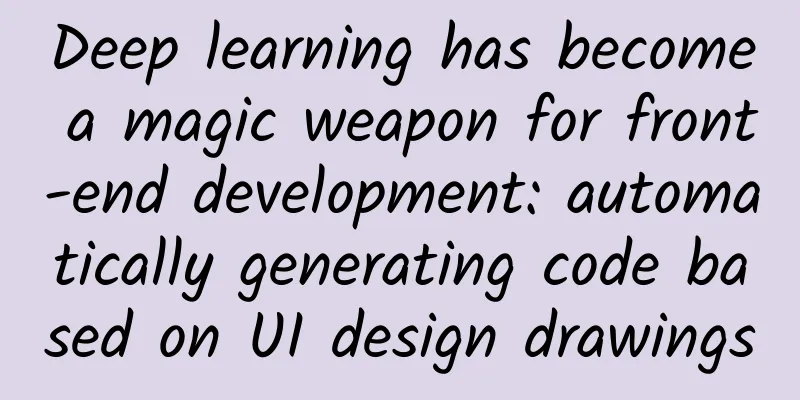Deep learning has become a magic weapon for front-end development: automatically generating code based on UI design drawings

|
A neural network may be needed between UI designers and front-end engineers. Recently, Uizard Technologies, a startup company in Copenhagen, developed a system called "pix2code". Using deep learning, this system can directly output the corresponding code based on the input graphical user interface (GUI) screenshot, thus eliminating the process of manual coding on the front end. Currently, the accuracy of the codes generated by pix2code has reached 77%, and these codes are compatible with three platforms: Android, iOS and Web interface. Just watch the video below to see how amazing it is. Tony Beltramelli, founder of UIzard, said that in order to come up with this neural network, the R&D team had to overcome three major difficulties:
Beltramelli also said that in the future, they may use generative adversarial networks (GANs) to further improve pix2code. GANs have proven their advantages in generating sequences and images, but because research in this field is still in a relatively preliminary stage, it still takes a lot of time to train the neural network. Attached paper address: https://arxiv.org/abs/1705.07962 GitHub address: https://github.com/tonybeltramelli/pix2code In addition, on GitHub, Beltramelli answered some common questions about pix2code. QuantumBit compiled this part as follows: Q: When will the dataset be made available? A: We submitted the paper to NIPS this year, and the dataset will be open to the public after they give the acceptance or rejection result, which will be around September. At that time, we will provide the GUI screenshots included in the dataset, the related DSL code, and three target codes for iOS, Android, and Web interfaces. Q: When will the source code be released? A: As written in the paper, we had no plan to open source the source code. But we didn’t expect this project to attract so much attention, so we decided to open source the pix2code implementation code and dataset mentioned in the paper. Q: Will pix2code support other target platforms/languages? A: No, pix2code is just a research project and it will remain as described in the paper. This project is really just a small demonstration of the work we do at Uizard Technologies. Of course, you are welcome to fork it and experiment on other target platforms/languages yourself. Q: Can I use pix2code in my front-end projects? A: No, pix2code is just an experimental project and you can't use it for your specific case yet. But we are working hard to make it commercially available. Q: How is the performance of the model measured? A: The accurate or incorrect results reported in the paper are obtained at the DSL level by comparing the generated tokens with the expected tokens. If there is any difference in length between the two, it will also be considered an error. Q: How long does it take to train this model? A: On an NVIDIA Tesla K80 GPU, it takes less than 5 hours to optimize the 109 * 10^6 parameters in a dataset. So if you want to train this model on three target platforms, it will take about 15 hours. Q: I am a front-end developer. Will I be unemployed soon? (I have asked this question many times with great sincerity...) A: AI will not replace front-end engineers so quickly. Even assuming that there was a mature version of pix2code that generated code 100% accurately on every different platform/language, a good front end would still need logic, interactivity, advanced graphics and animations, and all the other things that users like. Our goal in making this thing is to fill the gap between UI/UX designers and front-end developers, not to replace them. We hope to enable designers to create better, while allowing developers to spend more time on those core functions. We believe that in the future AI will collaborate with humans rather than replace them. -------------------------------------------------- Compiled by Tang Xu Quantum Bit Report | Public Account QbitAI |
<<: New features of iOS 11 SDK that developers need to know
>>: Aiti Tribe Stories (18): The Love Between Programmers and Code
Recommend
Do you feel that the channels are deceptive when promoting? See what the students in the channel say
As an operator who has worked in the mainstream i...
How to make a good APP online activity promotion plan?
Everything needs a plan, and APP operation and pr...
Can low power mode really extend the life of a mobile phone? I conducted an experiment with two Android flagships
When the battery is low, you may think of turning...
In-depth analysis of Xiaohongshu's operation and promotion through 7 modules!
This time, we invited a member of the e-commerce ...
Popular in Europe and America, fitness without equipment, functional training at home - [Animal Flow]
Popular in Europe and America, fitness without eq...
Ajun Short Video Operation Course, a systematic course starting from zero basis
Ajun Short Video Operation Course, a systematic c...
Angry at the richest man Wang Jianlin, overwhelming the official microblog giant Durex... Why is Haier's new media so popular?
Not long ago, an article titled " Haier , wh...
Dancing with Android in a World Without Kotlin
[[190578]] It's easier to start something tha...
my country's online audio-visual users exceed 900 million: average daily average of 110 minutes of short video viewing has become a time-killing tool
[[346254]] Nowadays, short videos have become a g...
Brother Nan: The Theory of Cause and Effect Followed by Successful People
Resource introduction of Nan Ge’s “The Theory of C...
Deconstructing the live streaming methods of e-commerce anchors
Can small-base accounts and white-label merchants...
How to promote WeChat official accounts and attract fans? How to accurately direct traffic to WeChat official accounts?
Before we knew it, WeChat official accounts have ...
Tik Tok operation is not difficult, you can understand it with a mind map!
With the gradual maturity of 5G technology, the s...
The download cost is 5.6 cents? This is how you promote and attract traffic on Zhihu!
My first impression of Zhihu came from a question...
In addition to operational knowledge, where can APP operations get inspiration?
On June 21, the article titled "Just now, th...




![[Comic] Programmers use Double 11 to get rid of 20 years of singles](/upload/images/67ebdc6373d54.webp)




